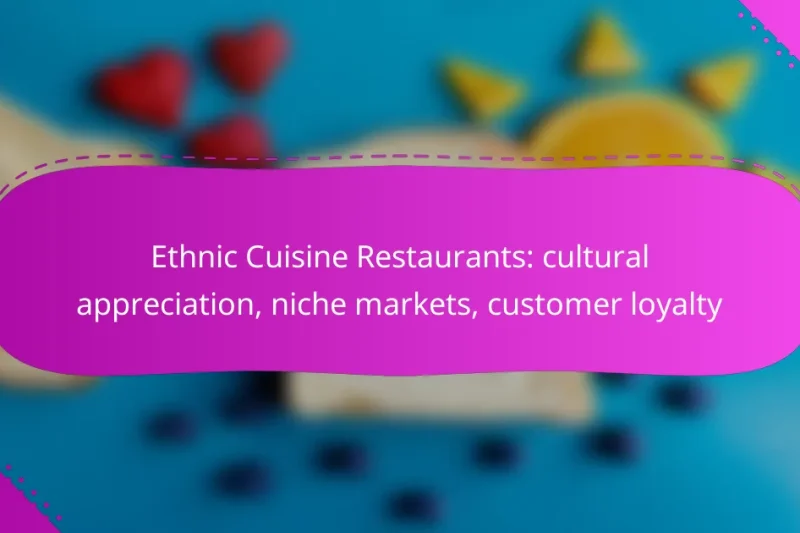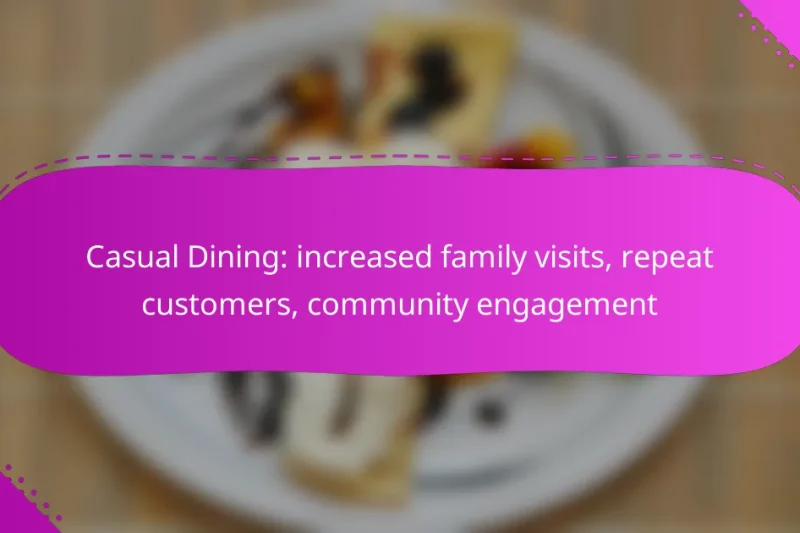Steakhouses in Canada are renowned for their premium reputation, built on high-quality ingredients and exceptional customer … Steakhouses: premium reputation, high customer retention, event hostingRead more
Outcomes of Choosing Different Restaurant Styles
Choosing a restaurant style can significantly influence the dining experience, with each option offering unique benefits. Fast food restaurants prioritize convenience and affordability, while casual dining establishments enhance the experience with a relaxed atmosphere and diverse menus. In contrast, fine dining venues focus on exceptional service and culinary artistry, making them perfect for special occasions. Understanding these outcomes can help diners select the right restaurant to suit their needs and preferences.
Brewpubs: brewing equipment, beer distribution, food pairing strategies
Brewpubs offer a unique blend of craft brewing and culinary experiences, making the selection of brewing … Brewpubs: brewing equipment, beer distribution, food pairing strategiesRead more
Ethnic Cuisine Restaurants: cultural appreciation, niche markets, customer loyalty
Ethnic cuisine restaurants play a vital role in enhancing cultural appreciation by offering authentic culinary experiences … Ethnic Cuisine Restaurants: cultural appreciation, niche markets, customer loyaltyRead more
Food Trucks: brand visibility, unique customer experiences, local partnerships
Food trucks serve as dynamic platforms for enhancing brand visibility, offering unique customer experiences that engage … Food Trucks: brand visibility, unique customer experiences, local partnershipsRead more
Fine Dining: high customer satisfaction, premium pricing, brand loyalty
Fine dining establishments excel in delivering high customer satisfaction by combining exceptional service, premium ingredients, and … Fine Dining: high customer satisfaction, premium pricing, brand loyaltyRead more
Vegan Restaurants: health-conscious clientele, sustainability impact, niche growth
Vegan restaurants are increasingly popular among health-conscious diners and those committed to sustainability, offering innovative plant-based … Vegan Restaurants: health-conscious clientele, sustainability impact, niche growthRead more
Buffet Restaurants: high volume sales, diverse customer base, event hosting
Buffet restaurants are a popular dining choice in Canada, known for their high-volume sales and ability … Buffet Restaurants: high volume sales, diverse customer base, event hostingRead more
Pop-Up Restaurants: trendsetting, brand awareness, market testing
Pop-up restaurants have emerged as a dynamic trend in the culinary world, offering brands a unique … Pop-Up Restaurants: trendsetting, brand awareness, market testingRead more
Casual Dining: increased family visits, repeat customers, community engagement
Casual dining establishments play a crucial role in increasing family visits by providing a welcoming atmosphere … Casual Dining: increased family visits, repeat customers, community engagementRead more
Fast Casual: rapid customer turnover, brand expansion, market adaptability
Fast casual restaurants have emerged as a dynamic segment in the dining industry, characterized by rapid … Fast Casual: rapid customer turnover, brand expansion, market adaptabilityRead more
What are the outcomes of choosing fast food restaurants in Canada?
Choosing fast food restaurants in Canada typically results in quick meals, affordability, and high customer turnover. These establishments cater to customers seeking convenience and value, making them a popular choice for many Canadians.
Quick service and convenience
Fast food restaurants are designed for speed, often delivering meals in under ten minutes. This quick service appeals to busy individuals and families who need to eat on the go. Many locations offer drive-thru options, further enhancing convenience.
For those who prefer dining in, fast food chains often have streamlined menus, allowing for easy decision-making and rapid order processing. This efficiency is a significant factor in their popularity, especially during peak hours.
Lower price points
Fast food restaurants in Canada generally offer lower price points compared to full-service dining options. Meals can often be found for under CAD 10, making them accessible for budget-conscious consumers. Value menus and combo deals further enhance affordability.
However, while the initial cost is low, frequent visits can add up over time. It’s essential to consider the long-term financial impact of regular fast food consumption versus occasional dining out at more expensive restaurants.
High customer turnover
Fast food establishments experience high customer turnover due to their quick service model. This means they can serve a large number of customers in a short period, maximizing revenue potential. During peak meal times, lines can form quickly, but the efficient service helps keep wait times low.
High turnover also allows these restaurants to maintain fresh ingredients, as food is prepared in smaller batches more frequently. This practice can contribute to better food quality, although it varies by location and chain.
How do casual dining restaurants impact customer experience?
Casual dining restaurants significantly enhance customer experience by providing a relaxed atmosphere, diverse menu options, and the opportunity for longer meal durations. These elements create a welcoming environment that encourages social interaction and enjoyment of the dining experience.
Enhanced dining atmosphere
The atmosphere in casual dining restaurants is typically designed to be inviting and comfortable, often featuring warm lighting and stylish decor. This ambiance encourages patrons to linger, making it ideal for gatherings with friends or family. Elements like background music and attentive service further contribute to a pleasant dining experience.
Considerations for enhancing the atmosphere include seating arrangements that promote conversation and the use of local art or themes that resonate with the community. Such touches can create a unique identity for the restaurant, attracting repeat customers.
Varied menu options
Casual dining establishments often offer a wide range of menu items, catering to diverse tastes and dietary preferences. This variety can include everything from classic comfort foods to healthier options, making it easier for groups with different preferences to find something appealing.
Restaurants may also introduce seasonal specials or local ingredients to keep the menu fresh and exciting. This adaptability not only satisfies customer cravings but also encourages patrons to return to try new offerings.
Longer meal durations
Casual dining restaurants typically allow for longer meal durations compared to fast food or quick-service establishments. This extended time encourages diners to relax, enjoy their meals, and engage in conversation without feeling rushed.
To optimize this experience, restaurants can implement strategies such as offering shareable plates or encouraging dessert orders. However, it’s essential to balance longer dining times with efficient service to ensure customer satisfaction and turnover rates remain healthy.
What benefits do fine dining establishments offer?
Fine dining establishments provide a range of benefits, including exceptional service, unique culinary experiences, and a higher level of ambiance. These restaurants focus on delivering quality and attention to detail, making them ideal for special occasions or a luxurious dining experience.
Exceptional service quality
One of the defining features of fine dining is the exceptional service quality. Staff are typically highly trained, knowledgeable about the menu, and attentive to guests’ needs. This level of service can include personalized recommendations, timely food delivery, and a focus on creating a memorable dining experience.
When dining at a fine restaurant, expect a higher staff-to-guest ratio, allowing for more individualized attention. This can enhance the overall experience, making guests feel valued and catered to throughout their meal.
Unique culinary experiences
Fine dining establishments often offer unique culinary experiences that go beyond standard fare. Chefs may use high-quality, seasonal ingredients and innovative cooking techniques to create dishes that are both visually stunning and flavorful. This emphasis on creativity can lead to memorable meals that are truly one-of-a-kind.
Many fine dining restaurants also provide tasting menus, which allow guests to sample multiple courses that showcase the chef’s skills. This format encourages exploration of flavors and can introduce diners to new ingredients and culinary traditions.
Higher price points
Dining at a fine restaurant typically comes with higher price points compared to casual dining options. Meals can range from moderate to high costs, often reflecting the quality of ingredients, the expertise of the chefs, and the level of service provided. It’s common for a multi-course meal to start at a few hundred dollars per person, especially in major cities.
While the prices may seem steep, many diners find that the experience justifies the cost. Consider budgeting for fine dining as part of a special occasion or celebration, ensuring you can enjoy the full range of offerings without financial stress.
What factors should be considered when selecting a restaurant style?
Choosing a restaurant style involves evaluating various factors that influence customer satisfaction and operational efficiency. Key considerations include understanding the target audience, assessing location and accessibility, and ensuring menu diversity to meet diverse tastes.
Target audience preferences
Identifying your target audience is crucial for selecting a suitable restaurant style. Consider demographics such as age, income level, and dining habits. For instance, a family-friendly restaurant may prioritize casual dining and kid-friendly menus, while a fine dining establishment might focus on a more upscale experience.
Engaging with potential customers through surveys or social media can provide insights into their preferences. Tailoring your restaurant style to meet these expectations can significantly enhance customer loyalty and satisfaction.
Location and accessibility
The location of your restaurant plays a vital role in its success. High foot traffic areas, such as shopping districts or near office buildings, can attract more customers. Evaluate the accessibility of your restaurant for different modes of transportation, including public transit and parking availability.
Consider local competition and the demographics of the area. A restaurant style that thrives in one neighborhood may not perform as well in another due to differing customer bases and accessibility factors.
Menu diversity
Offering a diverse menu can cater to a wider range of tastes and dietary preferences. Consider including options for various dietary restrictions, such as vegetarian, vegan, gluten-free, and allergen-friendly dishes. This approach can attract a broader audience and encourage repeat visits.
Regularly updating your menu based on seasonal ingredients and customer feedback can keep the dining experience fresh and engaging. Striking a balance between variety and specialization is key; too many options can overwhelm customers, while too few may limit appeal.
How do food trucks influence the restaurant landscape?
Food trucks significantly impact the restaurant landscape by offering a cost-effective and flexible alternative to traditional dining establishments. They allow entrepreneurs to enter the food industry with lower financial barriers and adapt to changing consumer preferences quickly.
Lower startup costs
Food trucks generally require a fraction of the investment needed for a brick-and-mortar restaurant. Initial costs can range from a few thousand to tens of thousands of dollars, depending on the vehicle and equipment. This lower financial commitment makes it easier for new chefs and food enthusiasts to test their culinary concepts without risking substantial capital.
Additionally, food trucks often avoid many of the overhead costs associated with traditional restaurants, such as rent and utilities, which can be significant in urban areas. This financial flexibility allows operators to focus on quality and innovation.
Flexibility in location
Food trucks can operate in various locations, allowing them to reach diverse customer bases. They can set up at festivals, markets, or busy street corners, adapting to where demand is highest. This mobility helps food truck owners maximize their sales potential by capitalizing on foot traffic and local events.
However, operators must be aware of local regulations regarding permits and zoning laws, which can vary significantly by city. Understanding these requirements is crucial to avoid fines and ensure smooth operations.
Trendy and unique offerings
Food trucks often specialize in trendy and unique culinary offerings, which can attract a dedicated following. They frequently experiment with fusion cuisines, gourmet ingredients, and innovative presentation styles that differentiate them from traditional restaurants. This creativity can lead to viral popularity through social media, enhancing visibility and customer engagement.
Moreover, food trucks can quickly adapt their menus based on seasonal ingredients or customer feedback, allowing them to stay relevant in a competitive market. This responsiveness can lead to a loyal customer base eager to try new dishes regularly.









